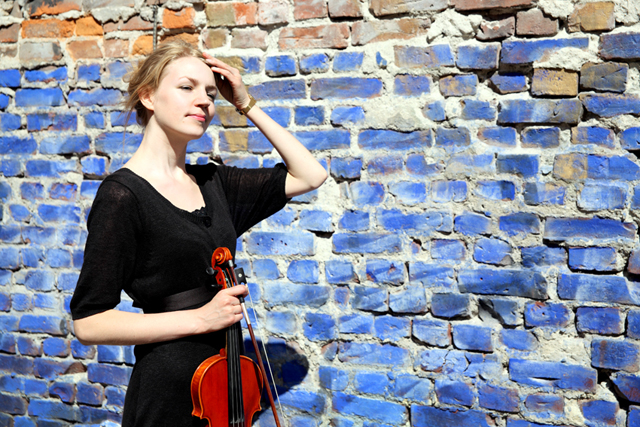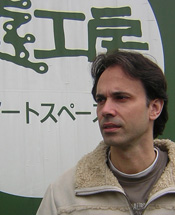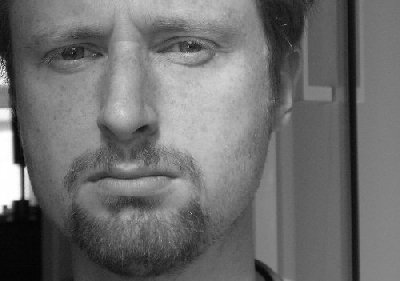
(pictured Iain McCurdy and Frøydis Dahlø)
This concert is a portrait of two very distinctive musical temperaments, the world re-nowned sound-artists Ricardo Climent and Iain McCurdy, with added flavours from one of the worlds most ingenious and humanist composers Helmut Lachenmann. The music is performed by two of scandinavias most fantastic musicians Frøydis Dahlø on Flute and Karin Hellqvist on Violin in combination with a perfect surround sound system. The inspiring project S.LOW Berlin and its founders Ricardo Climent and Iain McCurdy feature in the PUSH 2011 International Residency.
Saturday 18.30 – 19.30 IDKA Kulturkiosken
Program
• Toccatina - Helmut Lachenmann Violin Karin Hellqvist
• Traitement de choc – Iain McCurdy
• Annus Horribilies – Ricardo Climent
• Three Breaths, for Flute and Live Processing – Iain McCurdy
• Manhattan minuit – a 60 seconds miniature – Ricardo Climent
• Koorean Air for solo violin and electronic expression – Ricardo Climent
Flute - Frøydis Dahlø
Violin - Karin Hellqvist
Curation - Thomas Bjelkeborn
_____________________________________________________________________________________
Toccatina (1986) Helmut Lachenmann dur 5’00
”Nature loves to hide.” — Heraclitus
// the violinist barely executes a traditional sound but instead develops a noise created by tapping the metal screw at the end of the bow into the strings directly in quite conventional rhythms, and with precisely measured degrees of pressure and attack; at points nearly inaudible //
// for Lachenmann, nature is never merely lying ready to be disposed of; it ”loves to hide,” and can be approached only through peeling away the layers of the familiar. Spot-lighting the acoustic machinery of the instruments themselves becomes a means of setting their expressivity aglow; the splintering rejection of a musical metaphysics, a refusal to make ”music about music as a whole,” engenders through all its severe dedication an impossibly new metaphysics of music, both present and inaccessible; these sounds speak as if on no one’s behalf but their own //
// the sounds of the Toccatina are striking in their own right; but all these techniques and effects, as disorienting, challenging, and ultimately beautiful as they may be, are only the tip of the iceberg. In his own hobbled and occasionally cantankerous fashion, Lachenmann is a die-hard humanist, all the innovative and polemical aspects of his art ultimately a provide means of creating a more intimate and potent form of communication // ~ Seth Brodsky, Rovi
Excerpts from: http://www.answers.com/topic/toccatina-for-violin#ixzz1Ij4JHRjU
_____________________________________________________________________________________
Traitement de choc (2003) Iain McCurdy dur 11’12
All the sounds heard in Traitement de choc are derived from recordings made on various pianos.
The sound transformations used in this piece almost entirely make use of a number of granular synthesis devices of my own design. Having total control over the workings of these instruments allowed me to explore ideas such as regularity and periodicity in opposition to irregularity and non-periodicity in finer detail. Control over all attributes of the grains and of their parametric progression on a grain by grain basis offered the scope I required while using an otherwise tried and tested sound processing technique.
For the source recordings two different pianos were used. The first was a Steinway Grand, and the second was an unused piano which was no longer needed.
The significance of using a unwanted piano for some of the source recordings meant that certain techniques could be employed that could potentially damage the instrument. In fact, the recording of source materials for this piece resulted in the complete destruction of the piano.
Thanks are due to Queen’s University School of Music for the donation of a piano used during the preparation of this piece.
_____________________________________________________________________________________
1666: Annus Horribilies (2006) Ricardo Climent dur 5:52
The year of 1666 marked the climax of one of England’s worst periods in history. It was the year of the great fire of London, of the bubonic plague, and the year in which the English were defeated by the Dutch & French in several sea battles. In Continental Europe, in contrast, extraordinary events of an entirely different variety were taking place: in 1666 the first signed Stradivarius violin was created in Cremona, Italy; Elisabeth-Claude Jacquet de la Guerre, one of the best representative composers, performers, and improvisers of the Baroque era, was born; and Italian opera was flourishing with new works such as Francesco Cavalli’s Pompeo magno and Pietro Antonio Cesti’s Il Tito.
Inspired by the dualism of events, 1666: Annus horribilis is constructed in a simple AB form. Its journey commences with a sonic evocation of the agitation and humiliation resulting from the lowest peak of a great nation. The section is dry and built upon short and crude sound sources, moving fast in a complex but organised object-concrete counterpoint. Then, a spatial transition fades those events to a wide-open scenario where both the perception of time and the transition of sonic events dramatically slow down. This is followed by a more static, sustained scenario involving frozen chord-clusters resembling sonic pictures of de la Guerre’s clave works, which are timbrally distributed across the space in surround format. The structure’s sound-world highlights and exposes the impact of two different sonic environments both based on/both derived from the same world of sounds. In my compositional thinking, I mentally designed the architectonic and emotional scenarios of both Annus horriblis and Annus mirabilis and speculated on how they might project contrasted sonic and architectonic characteristics. As a result, I found the grounds to start organising and developing the materials at micro-structure level to satisfy my musical discourse, relying mostly on listening experience.
1666 was commissioned by Third Practice Festival, Virgina and it is dedicated to those who try to overcome the difficulties in hard times.
_____________________________________________________________________________________
Three Breaths (2009) for Flute, Bass Flute and Live Processing – Iain McCurdy dur 12’00
Three Breaths explores, in three short movements, three contrasting characteristics of the flute. The role of the computer is almost entirely that of live processing so that all sound produced represents transformations of the live sound of the flute. In particular in this piece, the computer analyses the pitch and dynamics played by the flute and uses this information to define certain aspects of the transformations implemented. This offers the player a degree of control of the live electronic and relinquishes the computer operator of some of this control.
_____________________________________________________________________________________
Manhattan minuit (2010) a 60 seconds miniature – Ricardo Climent dur 1’00
From the days when Peter Minuit purchased the territories of Manhattan for 60 guilders to the wrong American Indian tribe (back on May 24, 1626), to the Donald Trump era, one may argue that many things have changed in New York… but perhaps not that many!. Manhattan minuit is a one minute minuet dance, as a sonic celebration of the fact that existing Native American Indians and the cream of America’s real-estate business and entertainment resorts, have come to an even better understanding, permmiting the Trump’s casinos to be built in Indian reservations.
_____________________________________________________________________________________
Koorean Air (2010) for solo violin and electronic expression – Ricardo Climent dur 8’28
To write Koorean Air in collaboration with virtuoso violinist Darragh Morgan was very fun and rewarding. The nature of the methodology I employed in the compositional process dissolved the differences between composer and performer to the point that I no longer consider this work to be my piece but rather his piece or at least, let us say, our piece. However, I am glad that he is the one performing it, because I would not know what to do his £80,000 violin in my hands…
In the last few years, I seem to be less and less interested in what I think and more and more in what other people think, especially when we are exploring sound and gesture. It is like making a sonic documentary film of a performer. As a result, I have composed a number of pieces with the intention to feature (if not steal) the DNA of virtuoso performers; e.g. Esther Lamneck, Elisabeth McNutt, Kontakte Grup de Percussio and now Darragh Morgan, to go beyond my sonic creativity, by challenging their aural thinking through the process.
On a different matter, I presume that a piece for solo instrument is just that, a solo instrumental work. For years I wondered why when we combine solo instruments with electronics, in most cases, the end result becomes astronomical, hyper-loud and expansive, compared to the natural force of the instrument. In Koorean Air, I explored a process of electronic de-hyper- instrumentalisation (should this word exist!). I hope audiences will experience the electronic counterpoint as simply a dialogue between the violin and its true mirror, which is the performer’s fingerprints.
_____________________________________________________________________________________
Lachenmann was born in Stuttgart and after the end of the Second World War (when he was 11) started singing in his local church choir. Showing an early aptitude for music, he was already composing in his teens. He studied piano with Jürgen Uhde and composition and theory with Johann Nepomuk David at the Stuttgarter Musikhochschule from 1955 to 1958 and was the first private student of the Italian composer Luigi Nono in Venice from 1958 to 1960. He also worked briefly at the electronic music studio at the University of Ghent in 1965, composing his only published tape piece Szenario during that period, but thereafter focused almost exclusively on purely instrumental music.
Lachenmann has referred to his compositions as musique concrète instrumentale, implying a musical language that embraces the entire sound-world made accessible through unconventional playing techniques. According to the composer, this is music
in which the sound events are chosen and organized so that the manner in which they are generated is at least as important as the resultant acoustic qualities themselves. Consequently those qualities, such as timbre, volume, etc., do not produce sounds for their own sake, but describe or denote the concrete situation: listening, you hear the conditions under which a sound- or noise-action is carried out, you hear what materials and energies are involved and what resistance is encountered.
_____________________________________________________________________________________
Violinist Karin Hellqvist was educated at the Royal College of Music in Stockholm, Universität der Künste in Berlin and at the Norwegian Academy of Music in Oslo. In 2011 Karin graduates from her studies for an Artist Diploma in Performance at the Royal College of Music in London. She is also studying privately with violinist Melise Mellinger of German Ensemble Recherche.
As a violinist in a young generation of musicians engaged in contemporary music, she is active in several ensembles such as Oslo Sinfonietta, neoN (Norway) and Curious Chamber Players (Sweden). She dedicates her time to performing and commissioning new works as well as championing the established repertoire by Scandinavian and European composers, as a soloist or chamber musician. Karin’s work has been recognised by several major benefactors, for example the Dobloug Foundation, Norway, RWE Dea Norway/Germany, the Royal Swedish Academy of Music and the 45thInternational Summer Course for New Music in Darmstadt.
Festival performances include concerts at Prèsences, Paris, Ultima, Oslo, Venezia Biennale, Spor Festival Århus, Estonian Music Days, Stockholm New Music, Nordic Music Days, Sound Scotland, Arena Riga and for Nuovo Viruoso in Tokyo. Karin is dedicated to collaborating with other art forms; more recently with the Royal Dramatic Theatre in Stockholm and the Royal Swedish Ballet School.
_____________________________________________________________________________________
Frøydis Dahlø. Improv-musician from the norwegian .polar winter with a wide musical .plateau to work onwith.in clear musical expressions. Reductionistic improv , static and rythmic noise and groove. ÖNCZ.org, ensemble coordinateur, olle oljud/frøy støy, loxbo!dahlø!, zofia åsenlöf. Education in improvisation and composition from University in Stavanger, Gotlands tonsättarskola, NOTAM, Sund Folkehøyskole og NISS
_____________________________________________________________________________________
Ricardo Climent works in areas of music composition and interactive media, involving the use of audio and visual metadata. Currently, he serves as Co-Director of the NOVARS Research Centre, University of Manchester and he previously held a Lecturing position at SARC, Queen’s University of Belfast. Ricardo has also served as resident composer and researcher at the JOGV Orchestra in Spain, Conservatorio of Morelia in Mexico, Sonology – Kunitachi College of Music, Tokyo, LEA labs, at the Conservatorio of Valencia, the Cushendall Tower- In you we trust, Northern Ireland, at CARA- Celebrating Arts in rural Areas, cross-border Ireland and N.K. Berlin. He was involved in the creation of a number of collaborative projects, such as, The Microbial Ensemble, (repertoire for a bunch of microbes, with Quan Gan), The Carxofa Electric Band (a children’s project using vegetables and Electronics with iain McCurdy), The Tornado-Project (a cross-atlantic set of commissioned works for flute, clarinet and computer for American wind virtuosi Esther Lamneck (clarinet) and Elizabeth McNutt (flute)), Drosophila (a dance-theatre tour of a blind fly with KLEM and Idoia Zabaleta), Ho- a sonic expedition to Vietnam, (a 3D interactive interface project for planetariums), project manager for S.LOW, (a cross-disciplinary project in Berlin) and Manchester Sonic meta-ontology (Audioguides in collaboration with Mantis and NoTours among others)
web: sonorities.org
_____________________________________________________________________________________
Iain McCurdy is a composer of electroacoustic and acousmatic music originally from Belfast but currently based in Berlin. The current focus of his work is on sound installation, the creative use of electronic sensors and innovative human interface design. His work has been exhibited and performed throughout Europe and the rest of the World.






